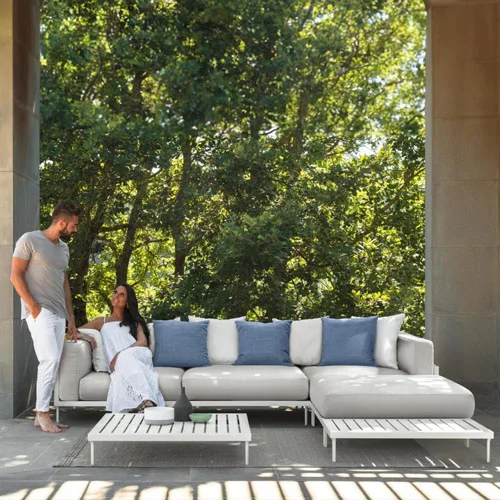
Patios can serve many functions besides relaxing: reading, dining or hosting parties can all take place here. By understanding its purpose before selecting furniture, you can design an adaptable floor plan to meet all of your needs.
An easy sofa and chair setup makes for the ideal environment for intimate conversations or reading a novel in comfort. A rug underfoot adds texture and color to complete the scene.
Focal Points
A focal point, whether natural or man-made, draws the eye and generates interest in a room. It may range from fireplace to dining table or outdoor features like firepit or water feature – when planning patio furniture layout it helps guide decisions regarding design decisions for all the areas involved.
If your natural feature includes stunning views or an outdoor kitchen, consider placing seating and tables so as to best display it. Doing this draws people in and promotes conversation or leisurely enjoyment in the space.
Focal points can also be created intentionally through wall paint or lighting that draws attention to artwork or decorative items. Alison Giese Interiors of Northern Virginia used large windows as focal points in this living room design; two lounge chairs and a leopard chair were placed strategically around them for visual balance and more intimate conversation spots, with a potted tree providing added greenery.
Planning the layout for patio furniture requires selecting one main focal point from the start; doing this saves both time and energy when selecting pieces that work together seamlessly. Depending on its purpose, this might involve selecting a dining table that can double up as both lounging space and dining table – this allows easy transition from lounging area to more formal seating arrangements when entertaining guests.
Once you’ve determined your focal point, the next step should be drawing the lines of your space. Most patio furniture manufacturers provide scale models to aid with spatial planning; if necessary you could make your own with paper and some painter’s tape. When ordering new pieces it may also be beneficial to map out how the arrangement will look before placing orders for new furniture pieces.
This room’s dining table, for instance, is set perpendicular to the sofa rather than parallel, creating an inviting arrangement that maximizes space utilization. Not only is eating easier thanks to this perpendicular position; diners won’t feel cramped.
Circulation
As part of your patio furniture layout design, don’t forget to account for air flow. A general guideline suggests leaving at least three feet between pieces to allow breezes to freely circulate in your yard and keep you comfortable. A screened porch may add even more airflow for maximum relaxation and ease.
An inviting sofa and chair arrangement, complete with coffee table, nestled beneath an outdoor canopy to provide shade, provides the ideal spot for reading or relaxing. An eye-catching patterned rug adds texture and an additional pop of color against its neutral palette.
Seating
A patio can serve multiple functions; from relaxation, dining and entertaining. Once you know how you plan to use your outdoor space, select seating arrangements that suit each activity best – for dining and lounging it may require different furniture pieces; but to maximize long-term success it would be prudent to buy multiple chairs, sofas and benches in one go.
Have extra seating is great for parties, but also ensure it suits everyday activities such as reading or relaxing with coffee or tea. A modular sectional offers flexibility without compromising seating capacity; alternatively a sofa with chair arrangement seats two comfortably for relaxing and dining purposes.
Those who enjoy sunbathing should add one or more chaise lounges for maximum relaxation while taking in the sunshine’s rays. Ottomans can add stylish seating solutions such as extra seating or foot rests; stacks of wicker chairs are another cute and casual way to bring more seating into an outdoor living area.
Organizing your patio seating areas into distinct seating zones helps create a more formal environment and makes meal times simpler for guests. Additionally, this arrangement makes guests easier to locate their seat when being served their meal.

